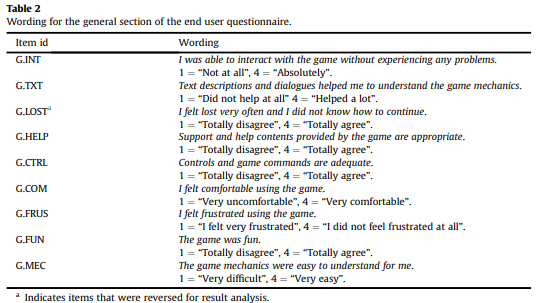Accessibility
User Testing & Accessibility in Games
Games Accessibility
Games accessibility is important, especially since games are incredibly important in creating a space where disabled people can have fun and create community at a lower barrier of access. This can be seen in the work of charities like Gamers Outreach who donate portable video game kiosks for hospitals. Beyond disabled people, games are also important in providing activity for the unemployed, in rehab and as an educational tool. Creating a universal experience for a variety of access needs is difficult, but I believe that with our genre, point and click, this will be easier to achieve as there will be no skill barrier. While there will be people that can not play our game due to the scary themes, since this is a core pillar, I don’t think it will be possible to convey the core experience to these players without changing the game fundamentally.
According to Palmquist, Jedel and Geothe (2024, pp. 44), ‘The Four Design Heuristics of AGE’, that being Fair and Flexible Play, Adjustable and Equitable Play, Logical Play and Error Prevention in Play, are important in considering Universal Design in video games. ‘Universal Design was a term the applied to environments, coined in the 1980s by Mace (Palmquist, Jedel and Geothe 2024, pp. 4). Universal Design uses the relational model in considering disability, “The relational model acknowledges both the medical and social model of disabilities and states that disability emerges in the mismatch or gap between the individual’s abilities and the environmental conditions that the individual faces” (Palmquist, Jedel and Geothe 2024, pp. 8). In a game environment, this would mean designing a space with a minimal mismatch between player ability and the game, which could adapt to any players needs. This does not treat disabled people as a ‘special case’ but benefits all players. Players needs are constantly evolving, so it is important to continue communicating with your player base. Below is the results of a survey evaluating different accessibility methods in a point-and-click serious game:



Applying the four design heuristics to our game and looking at ‘Game accessibility guidelines’ by Ellis et al. (2017), these are some ideas that I think are important to consider implementing to ensure accessibility.
Considering the first heuristic, fair and flexible play, our game should be fair in not just opportunity but also in outcome. This would allow as many people as possible to play the game, as the player chooses. We should also ensure that the game in inclusive in language and content as well as accessible, since the game should be enjoyable and avoid alienating players. Looking at the modalities of interaction, like visual, audio and motor (Palmquist, Jedel and Geothe 2024, pp. 45), these are some implementations we could consider making:
- readable font/high contrast colour/scaling fonts for people with visual impairments, for visually impaired, technological constraints or personal preferences.
- audio cues and subtitles for hearing impaired players/non-native speakers.
- narrative mode.
- localisation and translation considering culture and perception.
- we should allow to alter the control mapping of the game, and add an option for a controller for those that would prefer it or need it.
- access to settings like colour blindness filters so that colour blind people can play equally.
- adaptable sound for those sensitive to sound.
- using a high contrast colour palette, brightness options for those sensitive to light or trouble seeing.
- clear directions, bold keywords, dialogue history, objectives listed. People who can’t play in one sitting, for those that have a lower concentration level or worse memory.
- simple language to ensure that people with a different language level can access the game.
- ensure intuitive feedback for actions (visually and audibly).
- voice acting and text (low hearing or visibility).
- highlight interactive objects (intuitive design).
- fail safe features.
- minimise repetitive actions.